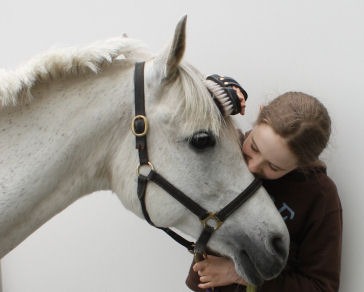Horsemanship Level 4: Full Practical Grooming
For Level 3 you had to identify and show knowledge of all the items in a complete grooming kit. For Level 4 you will need to put them to use:
4. Full practical grooming, complete kit.
The good news is we do not watch you groom. Instead you are expected to have your horse groomed and ready to present to the examiner, who will ask you questions about the procedures and tools you used. A practical grooming is a thorough grooming which should leave the horse clean and presentable. Braiding and clipping are not necessary. Here is what we will be looking for when you present your horse:
- The eyes are clear of any 'tears' or crusting.
- The nostrils and muzzle are clean.
- The bridle path is trimmed and the mane tidy. Your examiner will run her fingers through the mane and forelock to check for tangles.
- The coat should be clean when your examiner runs his hand over it. If it is summer the coat should be shiny. In winter we make allowances for winter coats, but they should still feel and look clean.
- White markings are white. Pay particular attention to socks on the back legs which tend to get manure stains. There are several spot removers and shampoos on the market that work wonders on white hair.
- The feet are picked and clean. Hoof oil is optional.
- The udder, sheath, and dock are clean. (This is an external glance only -- your examiner is not going to check your gelding for 'beans'!)
- The tail is neatly trimmed and free of tangles. When your examiner runs her fingers through the tail she should not encounter any resistance.
Keep a stable rubber handy so you can give your horse a final polish before presenting to the examiner. This is particularly handy if your horse grabbed an illicit mouthful of grass and now has green foamy lipstick, or if he left manure down his leg on the way out of the stable.
Bear in mind that it is very difficult to achieve this level of grooming if the day of your test is the first day all month you've groomed your horse. A shiny coat is a result of vigourous daily grooming and good nutrition. In addition, there are several steps you can take before the day of the exam to make grooming easier.
- A week before: pull your horse's mane, trim the tail, and cut the bridle path to the desired length. Trim jaw hairs but leave whiskers and eyebrows alone.
- The day before: if your horse tends to be greasy or muddy, bathe him and then put him in a weather-appropriate sheet to keep clean. Do this in the late afternoon so you can put him in a stall rather than a potentially muddy paddock for the night. Detangle his tail and make a simple braid below the bone to keep it clean and untangled. Tidy the mane and bridle path with scissors.
- The day of: unbraid the tail and groom as usual, doing a spot clean of white areas if necessary. Finish with the eyes, nose and dock.
You may be presenting your horse in a halter or a bridle, depending on what other tests you are doing that day. In either case make sure the tack is as clean as the horse!
In some ways it is artificial to have a perfectly clean horse. After all, horses are outdoor creatures and we all know they'll head to the nearest mud puddle as soon as we let them. However, the ability to present a moment of time in which your horse is fully groomed demonstrates the attention to detail a good horseman needs. If you missed a spot of manure on your mare's hock, you may also have missed a swelling or cut that could have serious implications. A full practical grooming shows you have examined your horse from head to toe, and that is where the greatest value in grooming lies.
Current and Upcoming Classes
The current series of Riding and Horsemanship classes and Riding 3+ classes however are full. The next series starts 13 March. There are a few spaces remaining in Horsemanship 3-4 and the Mounted Combat classes. All classes take place at Red Colt Co-op, 12320 No 2 Road, in Richmond.
Horsemanship Level 3-4
Sundays 31 January – 6 March, 10:30 – 11:30am
cost: $130 + gst
Intermediate Mounted Combat
Sundays 7 February – 6 March, 1pm – 3pm
cost: $160 + gst
Mounted Combat Fundamentals
Sundays 7 February – 6March, 1:30 – 3pm
cost: $120 + gst
Mounted Combat Assessments
Sunday 6 March, 1:00 – 4:30pm
cost: $50 for one assessment; $80 for two or more
one assessment included with each 5 or 6 week course
Beginner Riding & Horsemanship
Sundays 31 January – 6 March, 10am – noon – FULL
Sundays 13 March – 17 April, 10am – noon
cost: $300 + gst
Riding & Horsemanship Level 2
Sundays 13 March – 17 April, 10am – noon
cost: $300 + gst
Riding Level 3+
Sundays 13 March – 17 April, noon – 1pm
cost: $200 + gst
Mounted Combat Playday
Sunday 3 April, 1:00 – 4:00pm
cost: $15 + $15 for use of school horse
Free for ground crew & spectators!
